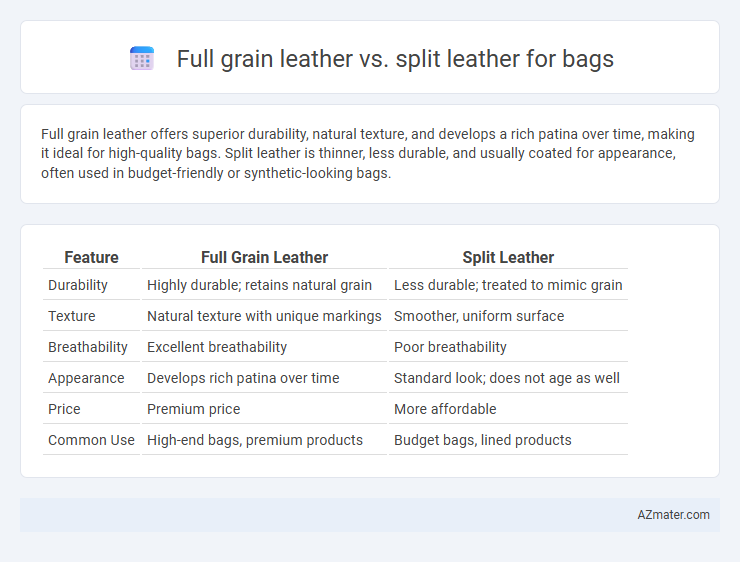Full grain leather offers superior durability, natural texture, and develops a rich patina over time, making it ideal for high-quality bags. Split leather is thinner, less durable, and usually coated for appearance, often used in budget-friendly or synthetic-looking bags.
Table of Comparison
| Feature | Full Grain Leather | Split Leather |
|---|---|---|
| Durability | Highly durable; retains natural grain | Less durable; treated to mimic grain |
| Texture | Natural texture with unique markings | Smoother, uniform surface |
| Breathability | Excellent breathability | Poor breathability |
| Appearance | Develops rich patina over time | Standard look; does not age as well |
| Price | Premium price | More affordable |
| Common Use | High-end bags, premium products | Budget bags, lined products |
Introduction to Full Grain and Split Leather
Full grain leather is made from the top layer of the hide, retaining the natural grain and imperfections, which provides durability, breathability, and a luxurious texture ideal for premium bags. Split leather comes from the lower layers of the hide, often treated and embossed to mimic grain, making it less expensive but less durable and prone to wear over time. Choosing full grain leather ensures longevity and natural aging, while split leather offers affordability with a compromise on strength and appearance.
What is Full Grain Leather?
Full grain leather is the highest quality leather made from the top layer of the hide, retaining its natural grain and imperfections that enhance durability and breathability. It develops a rich patina over time, making it ideal for premium bags that require strength and an attractive, authentic appearance. Unlike split leather, which is derived from the lower layers of the hide and often coated or embossed, full grain leather maintains its structural integrity and superior resistance to wear and tear.
What is Split Leather?
Split leather is a type of leather made from the lower layers of the hide after the top grain has been separated, resulting in a material that lacks the natural grain surface and strength of full grain leather. It is often coated or embossed to imitate the appearance of full grain leather but tends to be less durable and more prone to wear over time. Split leather is commonly used in more affordable bags, offering a cost-effective alternative while sacrificing some of the premium quality and longevity associated with full grain leather.
Key Differences Between Full Grain and Split Leather
Full grain leather retains the entire grain layer, offering superior durability, natural texture, and enhanced aging characteristics, making it ideal for high-quality bags. Split leather, derived from the lower layers of the hide, lacks the dense fiber structure, resulting in reduced strength and a smoother surface typically coated with synthetic finishes. Key differences include full grain's breathability and patina development, contrasted with split leather's affordability and uniform appearance but lower longevity.
Durability: Full Grain vs Split Leather
Full grain leather offers superior durability compared to split leather due to its intact natural grain, which retains strength and resistance to wear and tear. Split leather, made from the fibrous part beneath the grain layer, tends to be less durable and more prone to stretching or damage over time. For long-lasting bags, full grain leather ensures enhanced toughness and resilience against daily use.
Appearance and Texture Comparison
Full grain leather showcases a rich, natural grain with unique markings, offering a luxurious texture that becomes more supple and develops a distinctive patina over time. Split leather, derived from the fibrous part beneath the grain, has a smoother, more uniform surface often finished with artificial coatings, resulting in less breathability and reduced durability. The superior depth and natural feel of full grain leather make it the preferred choice for premium bags, while split leather offers a more affordable but less authentic look and tactile experience.
Cost Differences
Full grain leather bags generally command higher prices due to the durability and premium quality of the top layer of the hide, which includes natural grain patterns and greater resistance to wear. Split leather, derived from the lower part of the hide, undergoes additional processing and is often coated or embossed, making it more affordable but less robust than full grain leather. Cost differences can be significant, with full grain leather bags costing up to 50% more, reflecting their superior longevity and aesthetic appeal compared to split leather alternatives.
Maintenance and Care Requirements
Full grain leather bags require minimal maintenance thanks to their durable, natural surface that resists moisture and develops a rich patina over time with occasional conditioning using leather-specific products. Split leather bags often need more frequent care including thorough cleaning and application of protective coatings to prevent cracking and wear since their fibrous layer is less dense and more vulnerable to damage. Proper storage away from direct sunlight and humidity is essential for both types to prolong the lifespan and appearance of the leather.
Best Uses for Bags: Which Leather to Choose?
Full grain leather, known for its durability and natural texture, is ideal for high-quality bags that require longevity and develop a unique patina over time. Split leather, derived from the lower layers of the hide, is more affordable and often used in budget-friendly or fashion bags but lacks the strength and aging characteristics of full grain. Choosing between them depends on the bag's intended use: full grain leather suits premium, everyday or heirloom bags, while split leather fits casual, short-term, or decorative bags.
Conclusion: Selecting the Right Leather for Your Bag
Full grain leather offers superior durability, natural grain, and ages beautifully, making it ideal for high-quality, long-lasting bags. Split leather is more affordable and flexible but lacks the strength and character of full grain, often requiring additional treatments to enhance appearance and durability. Choosing the right leather depends on your budget, desired bag longevity, and preference for natural texture versus cost-effectiveness.

Infographic: Full grain leather vs Split leather for Bag
 azmater.com
azmater.com